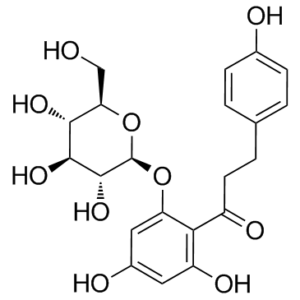Phlorizin (Floridzin; NSC 2833)
This product is for research use only, not for human use. We do not sell to patients.

For small sizes, please check our retail website as below: www.invivochem.com
| Size | Price | Stock |
|---|---|---|
| 25g | $650 | Check With Us |
| 50g | $1050 | Check With Us |
| 100g | $1600 | Check With Us |
Cat #: V5117 CAS #: 60-81-1 Purity ≥ 98%
Description: Phlorizin (phloridzin), a glucoside of phloretin which is a dihydrochalcone and a family of bicyclic flavonoids, is a potent and non-selective competitive SGLT inhibitor with Kis of 300 and 39 nM for hSGLT1 and hSGLT2, respectively.
Top Publications Citing Invivochem Products
Publications Citing InvivoChem Products
Product Promise

- Physicochemical and Storage Information
- Protocol
- Related Biological Data
- Stock Solution Preparation
- Quality Control Documentation
| Molecular Weight (MW) | 436.41 |
|---|---|
| Molecular Formula | C21H24O10 |
| CAS No. | 60-81-1 |
| Storage | -20℃ for 3 years in powder formr |
| -80℃ for 2 years in solvent |
| Protocol | In Vivo | Prior to Phlorizin treatment, the blood glucose level in SDT fatty rats is 370±49 mg/dL. Six hours after dosing, the blood glucose level in the Phlorizin treated group decreases to an almost normal level (139±32 mg/dL). Phlorizin-treated SDT fatty rats are heavier than vehicle-treated SDT fatty rats after 12 weeks. Phlorizin treatment significantly decreases glucose excretion and delays insulin decreases. Creatinine clearance decreases significantly with Phlorizin treatment. 23 weeks of Phlorizin treatment prevents the decrease of nerve fibers (23.6±3.2 fibers/mm). Retinal abnormalities are completely prevented with Phlorizin |
|---|
These protocols are for reference only. InvivoChem does not
independently validate these methods.
| Solvent volume to be added | Mass (the weight of a compound) | |||
|---|---|---|---|---|
| Mother liquor concentration | 1mg | 5mg | 10mg | 20mg |
| 1mM | 2.2914 mL | 11.4571 mL | 22.9142 mL | 45.8285 mL |
| 5mM | 0.4583 mL | 2.2914 mL | 4.5828 mL | 9.1657 mL |
| 10mM | 0.2291 mL | 1.1457 mL | 2.2914 mL | 4.5828 mL |
| 20mM | 0.1146 mL | 0.5729 mL | 1.1457 mL | 2.2914 mL |
The molarity calculator equation
Mass(g) = Concentration(mol/L) × Volume(L) × Molecular Weight(g/mol)
Mass
=
Concentration
×
Volume
×
Molecular Weight*
The dilution calculator equation
Concentration(start)
×
Volume(start)
=
Concentration(final)
×
Volume(final)
This equation is commonly abbreviated as: C1 V1 = C2 V2
Concentration(start)
C1
×
Volume(start)
V1
=
Concentration(final)
C2
×
Volume(final)
V2
Step One: Enter information below
Dosage mg/kg
Average weight of animals g
Dosing volume per animal µL
Number of animals
Step Two: Enter the in vivo formulation
%DMSO
+
%
+
%Tween 80
+
%ddH2O
Calculation Results:
Working concentration:
mg/ml;
Method for preparing DMSO master liquid:
mg
drug pre-dissolved in
µL
DMSO(Master liquid concentration
mg/mL)
,Please contact us first if the concentration exceeds the DMSO solubility of the batch of drug.
Method for preparing in vivo formulation:
Take
µL
DMSO master liquid, next add
µL
PEG300, mix and clarify, next add
µL
Tween 80,mix and clarify, next add
µL
ddH2O,mix and clarify.
Note:
- (1) Please be sure that the solution is clear before the addition of next solvent. Dissolution methods like vortex, ultrasound or warming and heat may be used to aid dissolving.
- (2) Be sure to add the solvent(s) in order.




































